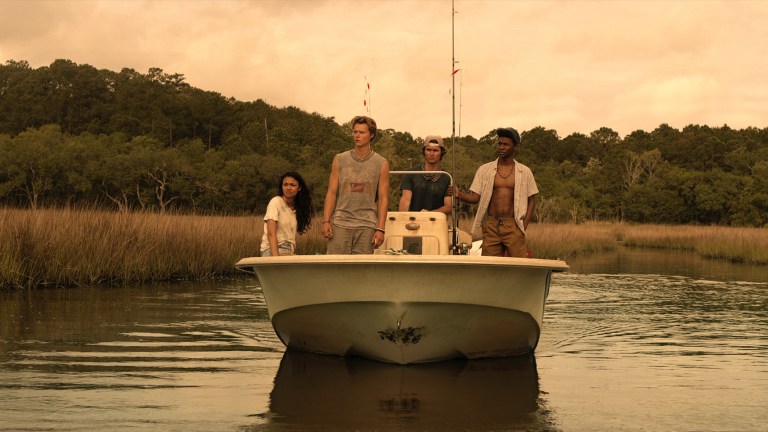Outer Banks Review (Spoiler-Free)
Outer Banks, Netflix's latest binge-friendly YA series, is a successful coming-of-age story amid an intriguing mystery.

This Outer Banks review contains no spoilers.
If you’ve ever wondered what would happen if Nicholas Sparks wrote National Treasure for a YA audience, the answer might be Outer Banks. After a hurricane takes out the power in their seaside town, the Pogues come across a wrecked ship, a discovery that launches them into a wild hunt for a missing parent and the treasure he spent his life searching for.
Outer Banks is your classic coming-of-age story told over a backdrop of a mystery and danger, complete with your boy next door, brainy Black friend, troubled bad boy, and “not like other girls” girl. The Outer Banks (OBX) is divided into two distinct groups, the haves, Kooks —kids with rich parents who tear up the town in cardigans and boat shoes— and the have-nots, Pogues— working-class youth whose parents are too busy keeping food on the table to supervise their teen-aged kids. John B (Chase Stokes), J.J. (Rudy Pankow), Pope (Jonathan Daviss), and Kiara (Madison Bailey) make up the main gang of Pogue protagonists.
John B. is the de facto leader of the Pogues. He’s smart, laid-back, and attractive in the way introspective boys tend to be. He’s likable, and it’s easy to see why his friends would wade into turbulent waters with him. J.J. is the troublemaker, a victim of parental abuse, and in desperate need of hugs and therapy. His “f_ck it” attitude brings the spontaneity, and the problems, but he’s loyal and down for whatever. Pope is a Black boy in a fairly monotone town, which the writing doesn’t seem to fully appreciate. He’s smart as hell, but he can be peer-pressured into anything, including disobeying his dad right to his face, or as some of us call it — white people shit. Kiara comes from a family with means, which makes her a Pogue by choice and association. She’s a little bit like each of the boys, smart, loyal, charismatic, and she always rides for her friends.
Where teen protagonists are often grating, the Pogues manage to stay just behind that line. As characters, they embody all of the chaos and turmoil that comes with growing up, and the actors imbue them with a sincerity that endears them to you. The same, however, cannot be said for the Kooks. Sarah (Madelyn Cline) is the “princess” who loves attention and does everything on ten. She treats every single moment like a Broadway audition, and pulls focus in any space she’s in. Her boyfriend, Topper, is almost The Worst, but that title belongs to her older brother, Rafe (Drew Starkey). We are clearly supposed to hate these people.
This indistinct North Carolina beach town is defined by its class division. “Pogue” and “Kook” aren’t just terms locals use to identify someone from a particular part of town, they inform everything— who you’re friends with, where you hang, and where you fall on the social ladder. They are personality traits.
Outer Banks is On My Block with more white kids and less humor. That isn’t meant to be a direct comparison, or a judgment, because they are drastically different shows, even where some story elements might overlap. Both shows feature young protagonists from a working-class neighborhood, who by happenstance, end up on a treasure hunt. And both put kids in wildly dangerous situations that beg the question, “where are all the adults?!” But they aren’t the same in aesthetic or tone.
Outer Banks feels like it can take place at any point in time, which is probably down to the fact that the town is without power for the majority of the season. The appeal of vacationing in a small beach town is the arcadian quality you wouldn’t get in an urban environment. That gives the setting a rustic, timeless feel. It also provides a very distinct visual cue for the world you’re occupying at any time. Kooks have generators, and are going about business as usual, perhaps a metaphor for the power rich folks have in society in general. But if the show is making a critique on wealth, or nepotism, it isn’t saying anything new. And that’s fine. I’m much more interested in the intrapersonal dynamics between the Pogues and their clashes with the Kooks.
Outer Banks is better than it ought to be. When the story is focused on the mystery of John B’s missing father, or the search for treasure, it hits on several levels. But when it gets caught up in teenage romances, it leans too heavy on soap operatics, opting to do The Utmost when less would suffice— and be preferable. Sarah and John B. become entangled, and when Topper finds out, his behavior is not just outta pocket, he looks for the pocket so he can actively avoid it. These characters are prone to dramatics in a way that’s almost hilarious, if it didn’t detract from scenes.
I finished the season in two sittings over as many days. Outer Banks is a perfect binge show, at 10 hour-long episodes. It escalates just enough each episode to keep you on the hook, and follows through with a satisfying crescendo that builds on everything before it. Given that Netflix has taken to cancelling anything that doesn’t hit the elusive metrics they never share, it’s hard to say whether the show will be renewed. But if Outer Banks comes back for a second season, I will be reminding Netflix that I am “still watching.”
All episodes of Outer Banks premiere April 15 on Netflix.